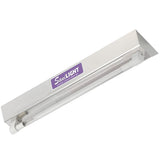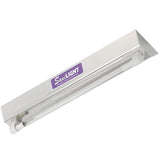Using Ultraviolet Light to Deactivate Harmful Airborne Microbes
Posted by Dave on for ProLampSales
The germicidal portion of the ultraviolet spectrum provides an extremely powerful method of addressing sanitation issues for both water and air environments. We have already addressed UV water applications in another blog post. In this post we will look at both commercial / industrial and residential applications for using ultraviolet germicidal irradiation (UVGI) to disinfect room air.
UVGI has been available for decades and used primarily in specialized industrial and medical applications. Increased interest by the public in indoor air quality has prompted wider use of UVGI in many types of air sanitation applications.
Headlines about Ebola, pandemic influenza, drug-resistant tuberculosis, bio-terrorism and other airborne diseases have contributed to a renewed focus on methods to effectively address harmful indoor air conditions.
A National Institute of Health report stated "There is a long history of investigations concluding that, if used properly, UVGI can be safe and highly effective in disinfecting the air, thereby preventing transmission of a variety of airborne infections."
UVGI: What Is It? How Does it Work?
The UV portion of the electromagnetic spectrum consists of three wavelength ranges: UV-A (400nm to 315nm), UV-B (360nm to 280nm) and UV-C (254nm target).
UV-A includes backlights. UV-B is primarily used for phototherapy and industrial analysis. UV-C, also called germicidal, is used for air and water disinfection. This blog post is about sanitizing indoor air with germicidal, UV-C light.
Specially designed low pressure mercury lamps emit ultraviolet (UV-C) radiation usually optimized at a wavelength of 254 nanometers (nm) for maximum effectiveness.
Germicidal radiation kills or inactivates microbes by damaging their DNA. Dose and exposure times vary by application.
There are two primary approached to disinfecting room air using germicidal lamps: Upper Room UVGI and In-Duct UVGI.
UVGI: Upper Room Applications
Upper Room UVGI is designed to operate in a layer of air along the ceiling. This approach allows people to occupy the room while the UVGI system functions. Upper-room installations use wall-mounted and ceiling-suspended fixtures that are shielded to confine the germicidal radiation to the area above people's heads. This minimizes exposure to occupants in the room. According to the NIH report, "Effective air disinfection in the breathing zone then depends on good vertical air movement between the upper and lower room, which can be generated naturally by convection, the HVAC system, or low-velocity paddle fans where needed."
Suitable applications for Upper Room UVGI are offices, medical centers, laboratories, clean rooms and dairy plants with ceiling heights that can accommodate the fixtures without compromising the safety of the occupants in the spaces. View examples of these UVGI fixtures from our site. The lamps inside the fixture have specific UV watt output and base types. Replacement lamps must be chosen to match the original lamp specification.
UVGI: In-Duct Applications
In-Duct UVGI, as the name implies, is installed directly in the HVAC system and is designed to disinfect the air before it is re-circulated or exhausted from the building. The in-duct location of the germicidal lamps, completely isolated from the occupants of the building, allows higher intensity irradiation than can safely be used in the Upper Room application.
The effectiveness of an In-Duct system depends on the amount of air and the velocity of the air circulating through the ducts. The more air exposed to the germicidal irradiation, the more effective the disinfection. However, pushing the airflow to higher rates has limits. If the air flow through the system is tuned to the HVAC requirements for occupant comfort, the UVGI effectiveness should be good.
Suitable applications for In-Duct UVGI include homes with ducted HVAC systems as well as commercial offices, schools and medical facilities.
For homes, heating and cooling system manufacturers may offer easy to install In-Duct UVGI modules. Honeywell sells a do-it-yourself installed UV treatment system. They also have other In-Duct UVGI systems that require professional installation as do other HVAC manufacturers.
Safe Handling and Use of Germicidal Lamps
All ultraviolet radiation is harmful to human eyes and skin. The shorter the wavelength the greater the potential damage to eyes and skin. UV-C radiation can be extremely harmful to humans. Use caution when working with these lamps. Never look directly at an ultraviolet lamp when it is turned on.
- Posted in Ultraviolet Light
Featured Products (View All)
0 Comments




